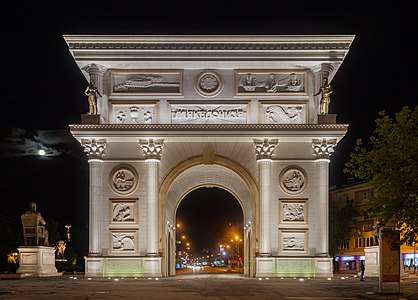Skopje 2014
Skopje 2014 (Macedonian: Скопје 2014) was a project financed by the Macedonian government of the then-ruling nationalist party VMRO-DPMNE, with the official purpose of giving the capital Skopje a more classical appeal.[1] The project, officially announced in 2010, consisted mainly of the construction of colleges, museums and government buildings, as well as the erection of monuments depicting historical figures from the region of Macedonia. Around 20 buildings and over 40 monuments were to be constructed as part of the project.[2]
The project was seen as politically controversial in its nature and as a nation-building endeavour, as it tried to further impose the narrative of Macedonian history, promoting a Macedonian identity with unbroken continuity from antiquity over the Middle Ages to the modern times.[3] Skopje 2014 has also generated controversy for its cost, for which estimates range from 80 to 500 million euros.[4][5]
The Skopje 2014 project encompassed the construction, from 2010 to 2014, of 136 structures built at a cost of more than US$700 million.[6]
Background
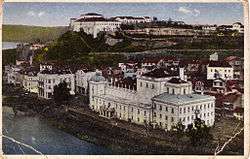
The 1963 Skopje earthquake destroyed approximately 80% of the city, including most of the neoclassical buildings in the central part of Skopje.[7] The rebuilding that followed saw the construction of mostly plain modernist architecture. This is one of the reasons given by the VMRO-DPMNE government for the necessity of the project, to give Skopje a more monumental and visually pleasing image. Another reason is to restore the missing sense of national pride and create a more metropolitan atmosphere.[8] In a speech at the opening of Porta Macedonia in January 2012, then Prime Minister Nikola Gruevski stated that Skopje 2014 was his idea.[9]
Criticism
The Skopje 2014 project has been criticized by various groups since the time it was first announced. The cost of the project is estimated at anywhere from 80 to more than 500 million euros[10][11] and is seen by many as a waste of resources in a country with high unemployment and poverty. The project is also believed by critics to be a distraction from these problems.[8]
The Social Democratic Union of Macedonia, the main opposition party, opposes the project and has alleged that the monuments could have cost six to ten times less than what the government paid.[12]
The project is seen as a part of the government's "antiquisation" policy, in which the country seeks to claim ancient Macedonian figures like Alexander the Great and Philip II of Macedon for itself. The timing of the project, following the country's non-invitation to NATO due to its continued naming dispute with Greece, has led to speculation that it is retaliation or an attempt to put pressure on Greece.[13] Some residents see the scheme as the embodiment of nationalism by a conservative government focused as much on giving the metropolis a facelift as changing the nation's history and have described it as a mini-Las Vegas[14] while others appreciate its classical nod to the past.[15]
Sam Vaknin, a former adviser to Nikola Gruevski, has stated that the project is not anti-Greek or anti-Bulgarian, but anti-Albanian. In an interview, he said "Antiquisation has a double goal, which is to marginalise the Albanians and create an identity that will not allow Albanians to become Macedonians."[13][16] To shift attention from Albanians being absent from the Skopje 2014 project, the Macedonian government agreed to fund Skanderbeg Square built around the existing Skanderbeg monument in the part of Skopje with a majority Albanian population.[16] Later additions to the Skopje 2014 project were made that included depictions of ethnic Albanians in the monuments such as Nexhat Agolli, Josif Bageri, and Pjetër Bogdani, as well as others on the Art Bridge.
Architects have criticized the aesthetics of the project and believe the money could have been spent on constructing modern buildings.[8] It has also been described as nationalist kitsch[17][18] which "brings unknown history" to the citizens[19] and current prime minister Zoran Zaev has labeled it an "idiotic project".[20]
2018
In late February 2018, the government and institutions of the Republic of Macedonia announced the halt of the Skopje 2014 program and begun removing its controversial monuments and statues. The Macedonian Ministry of Culture also has set up a Commission to envisage the possibility of removing the rest of them, such as of Alexander the Great and Philip II of Macedon. As a first step, the monument of Andon Kyoseto was dismantled, as one of the mostly disputed of the project.[21][22][23][24][25][26][27] In June 2018 the Macedonian Government announced that the monuments would be renamed and marked with inscriptions honouring Greek-Macedonian friendship.[28]
Plans
Bridges
New bridge constructions
Art Bridge
The Skopje 2014 project calls for two new pedestrian bridges to be built across the Vardar in the centre of the city. One is the Art Bridge, which is being constructed between the Freedom Bridge and the also under-construction Eye Bridge. It is expected to cost 2.5 million euros. The bridge will include 29 sculptures, with 14 at each end and one in the centre. It will be 83 metres (272.3 feet) in length and 9.2 m (30.2 ft) in width, while the central part of the bridge will be 12 m (39.4 ft) wide.[29]
Eye Bridge
The other bridge being constructed as part of the project is the Eye Bridge. Situated between the Stone Bridge and the under-construction Art Bridge, it began construction in 2011. The pedestrian bridge will include 28 sculptures and will cost around 1.5 million euros.[30]
Existing bridge renovations
Freedom Bridge
The project also includes plans to renovate existing bridges in central Skopje, one of which is the Freedom Bridge, which connects Vojvoda Vasil Adžilarski Street in Centar Municipality to Stiv Naumov Street in Čair Municipality. First constructed in 1936, the renovation began in 2011 and is expected to be completed in May, 2014. The total cost will be roughly 1.15 million euros.[31]
Goce Delčev Bridge
The renovation of the Goce Delčev Bridge, which connects Ilinden Boulevard in Centar to Goce Delčev Boulevard in Čair across the Vardar, began on April 11, 2011[32] and finished later in the year. The renovation included new gold-coloured fencing and 26 lampposts. The project cost roughly 500,000 euros, including 60,000 euros for the new lighting.[33] Four statues depicting lions, two at each end, were also placed on the bridge in 2010. The ones on the western side were cast in Florence and cost 1.5 million euros.[34]
Revolution Bridge
The Revolution Bridge, first built in 1963 across the Vardar connecting Kočo Racin Boulevard in Centar to Krste Misirkov Boulevard in Čair, was also renovated as part of the Skopje 2014 project. It began on December 9, 2010 and was completed in May, 2011. The renovation included basic repairs as well as the installation of 22 lampposts and iron-wrought fencing. The renovation cost 450,000 euros.[35]
Cultural buildings
Macedonian Philharmonic Orchestra hall
Notable in Skopje 2014 for its bold modern architecture as opposed to the usual neoclassical style seen in the project, the under-construction concert hall to house the Macedonian Philharmonic Orchestra is one of the first buildings to begin construction in the project, with the cornerstone having been laid in June 2009. The exterior of the building is nearing completion. The concert hall is planned to have excellent acoustics and will have a capacity of 900 seats.[36]
Museum of Archaeology

The Museum of Archaeology began construction in 2009 and opened in September, 2014.[37] Although the building primarily serves as a museum, it also houses the Constitutional Court and the National Archive of the Republic of Macedonia. It is situated on the eastern bank of the Vardar, across the river from Macedonia Square. The exterior of the museum is among the more monumental buildings of the project, with its Greek Revival architecture.[38] VMRO-DPMNE, the ruling party, states the budget for the construction as 436,000,000 denars.[39]
Museum of the Macedonian Struggle
The Museum of the Macedonian Struggle for Statehood and Independence − Museum of VMRO and Museum of the Victims of the Communist Regime exhibits the strive for an independent Macedonian nation from the Ottoman Empire and later Yugoslavia. It is divided into 16 departments and includes over 100 wax figures of historical individuals. The museum lies on the eastern bank of the Vardar River just northwest of the Museum of Archaeology, opposite Macedonia Square. Construction began in June 2008 and it formally opened on September 10, 2011. The total cost of the museum, which covers 2,500 m2 (26,909.8 ft2), was roughly 10 million euros.[40]
National Theatre
The former National Theatre destroyed in the 1963 Skopje earthquake will be completely reconstructed, as part of the Skopje 2014 project. Construction of the building, however, began in December 2007, three years before the official announcing of Skopje 2014. Construction was originally planned to be completed in 2009, though it ended up being completed a few years after.[41] The theatre stands on its original location on the eastern bank of the Vardar. The cost is estimated to be at least 6 million euros[42] and may be as high as 30 million euros.[2]
Façade reconstructions
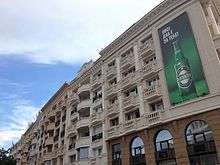
The Skopje 2014 project also includes plans to transform the façades of existing buildings in central Skopje into the neoclassical style. This includes the following buildings:
- Buildings along Dimitrija Čupovski Street[43]
- Buildings along Macedonia Street[43]
- Buildings along Nikola Vapcarov Street[43]
- Buildings around Macedonia Square[44]
- City Trade Center[45]
- Department of Transport and Communications Building, located on Karpoš's Rebellion Square.[46]
- Government of the Republic of Macedonia building. The new façade appearance choice for this building was made by the Macedonian public through online votes on the government's website. There were five choices and the neoclassical choice won a plurality.[47]
- MEPSO Building, located north of Macedonia Square.[48]
- Ministry of Justice building[49]
- Parliament building. The renovation of the Parliament also includes the construction of cupolas atop the building.[50]
Government buildings
The following are new buildings being constructed to house various governmental functions.
Agency for Electronic Communications
The cornerstone for the new building to house the Agency for Electronic Communications was laid on 30 March 2011. It is being constructed on the eastern bank of the Vardar in between two other Skopje 2014 buildings, the Museum of Archaeology and the Financial Police Building.[51]
The total cost of the building's construction is around 8.5 million euros, which the government claims will be fully funded by the Agency's budget. It is expected to be completed in 15 months or by the late summer of 2012.[52]
Criminal Court Building
A new Criminal Court Building is being constructed as part of the project. The cornerstone for the building was laid on 25 May 2010. The building, 10 stories tall, has been topped out. In it will be 74 judicial offices, 22 high courts, and 2 large courtrooms. The 2-story basement will contain parking. The building, reported to cost 8.3 million euros, was planned to be completed after 18 months of construction.[53]
Financial Police Building
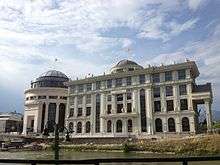
On 11 October 2010 the cornerstone for the new building to house the Financial Police of the Republic of Macedonia was laid. The site is located between the new Ministry of Foreign Affairs and the new Agency for Electronic Communications. The building, currently several months from completion, is cylindrical in shape and is capped by a dome-shaped roof. The total cost of construction will be roughly 13 million euros.[54]
Ministry of Finance
The government, in March 2011, invested 8.9 million euros into transforming an abandoned uncompleted building in central Skopje into a new home for the Ministry of Finance. Like the other governmental buildings in Skopje 2014, it will have a neoclassical appearance. Though it was scheduled to be completed in the first quarter of 2012, the building remains far from completion.[55]
Ministry of Foreign Affairs
Construction of the new Ministry of Foreign Affairs building began in January 2010. It is located on the eastern bank of the Vardar between the Financial Police Building and Stiv Naumov Street. It will have two basement levels, seven above-ground levels, and a terrace atop the building. The building, which is nearly complete on the exterior, stands at a height of 27 m (88.6 ft) and will have costed 13.5 million euros when completed.[56]
New City Hall
A new city hall for Skopje is being constructed below the Kale Fortress, on the eastern bank of the Vardar. It is being constructed, as most other buildings in the project, in the neoclassical style and will cost roughly 15 million euros. It will be 21 m (68.9 ft) tall, with six above-ground floors.[57]
Old City Hall
Although a new city hall for Skopje is being constructed, the former one destroyed in the 1963 Skopje earthquake will be fully reconstructed, as part of the Skopje 2014 project. It will be built on its original location at the north side of Macedonia Square, to the west of the Vardar Quay. A Greek investor will be building the Old City Hall, as well as a Marriott Hotel to the immediate left of the building, after purchasing the land in March 2011.[58]
Water Management Building
Among the buildings being constructed below the Kale Fortress on the eastern bank of the Vardar is the Water Management Building. Construction of the building began in December 2011. It is expected to be completed in 3 years at a cost of 10 million euros.[59][60]
Monuments
Justinian I
The monument of Justinian I, born in Tauresium just outside modern Skopje, arrived at Macedonia Square on June 16, 2011. Similar to the monument of Tsar Samuil, also on Macedonia Square, it consists of Justinian I sitting on a throne, which is placed on a pedestal. The monument is made of white marble with the exception of the bronze reliefs on the pedestal, also characteristics it shares with the Tsar Samuil monument. The pedestal is 3.5 m (11.5 ft) tall, while Justinian upon his throne measures a further 5 m (16.4 ft) in height.
The monument sits just north of the Stone Bridge, at the western bank of the Vardar River. It was made in Florence and cost over 1 million euros.[61]
Sculpted by hand in the Bazzanti Art Gallery marble Studio of Florence.
Mother Teresa
The construction of a monument consisting of a statue of Skopje native Mother Teresa and a fountain is planned. The monument will be located near the MEPSO building, which is north of Macedonia Square near the Vardar Quay, though location on the roundabout near the Goce Delčev Bridge is also a possibility. It is planned to stand around 30 m (98.4 ft) in height, even taller than the Warrior on a Horse monument.
It has been reported that a donation from India will fund the construction of the new Mother Teresa monument, who is already memorialized in the city with the Memorial House of Mother Teresa and a plaque marking the spot of her birth.[62]
Pavilion at Macedonia Square
The Pavilion at Macedonia Square is situated on the north side of Macedonia Square. Construction began in early 2011 and was completed later that year at a cost of 350,000 euros.[63] The pavilion consists of a dome supported by several columns, covering a statue of a romantic couple.
Porta Macedonia
One of the main symbols of the project is Porta Macedonia, a triumphal arch situated on 11 October Street, near Macedonia Square. The arch is meant to commemorate the long struggle for Macedonian independence. It is 21 m (68.9 ft) tall and contains 32 reliefs carved on the outside, depicting events from pre-history to the independence of the Republic of Macedonia. The inside of the arch consists of two levels, in which a souvenir shop and a gallery are located, and a rooftop observation deck. It formally opened to the public on Christmas Eve, January 6, 2012. The construction of Porta Macedonia is estimated at 4.5 million euros.[64]
Tsar Samuil
The monument to Samuel of Bulgaria is among the new focal points of Macedonia Square. Officially unveiled on 28 June 2011, it is situated in front of the Pelister building, to the right of where Macedonia Street meets Macedonia Square.[65]
The monument, mostly in white marble, consists of a depiction of Tsar Samuil sitting on a throne, totaling 5 m (16.4 ft) in height, and is placed on a pedestal which itself is a further 3.5 m (11.5 ft) tall. The reliefs on the sides of the pedestal are bronze. Tsar Samuil, in the monument, holds a scepter. Made in Florence, sculpted by hand in the Bazzanti Art Gallery marble Studio, the total cost of the Tsar Samuil monument was roughly 3.5 million euros.[66]
Samuil's empire was centred within the territories of today's North Macedonia with Skopje and later Ohrid being the empire's capital.[67] The fringe theory Samuil being the first Tsar of the Macedonian Slavs is held mainly in North Macedonia.[68] This view is ahistorical, as it projects modern ethnic distinctions into the past.[69]
Warrior monument
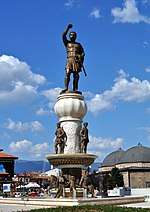
On the opposite side of the Stone Bridge from Macedonia Square is Karpoš's Rebellion Square, which serves as a main entrance to the Old Bazaar. It is undergoing a major reconstruction, as part of Skopje 2014, and its new centerpiece will be the statue and fountain officially named "Warrior," though it is widely believed that the statue is a depiction of Philip II of Macedon, not to be confused with the equestrian statue of Philip II in Skopje's Avtokomanda neighborhood. The statue was placed onto the square on 22 May 2012.
Made in Vicenza, the statue is 15 m (49.2 ft) tall and is placed on a 13 m (42.7 ft) tall pedestal. The entire monument will cost roughly 2 million euros.[70]
Warrior on a Horse monument
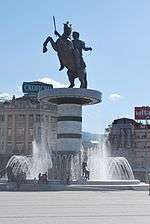
Perhaps the main symbol of the Skopje 2014 project is the Warrior on a Horse (Macedonian: Воин на коњ) statue and fountain in the centre of Macedonia Square. It was typically thought to depict Alexander the Great, though it was not officially named for him.[71][72][73] A plaque was later added to the statue which confirmed that the statue was dedicated to Alexander the Great.[74]
The statue was sculpted by Valentina Stevanovska and cast in bronze with lost wax casting technique in the Ferdinando Marinelli Artistic Foundry of Florence.
"Alexander" was officially completed on September 8, 2011 to commemorate 20 years of the independence of the Republic of Macedonia. It is 14.5 m (47.6 ft) tall and it sits on a cylindrical column, which itself is 10 m (32.8 ft) in height. The column consists of three large ivory sections, each separated by a thinner bronze ring. Each section contains reliefs. The column stands in a fountain. At the base of the column are 8 bronze soldiers, each 3 m (9.8 ft) tall. There are also 8 bronze lions, each 2.5 m (8.3 ft) tall, around the edges of the fountain pool, four of which act as part of the fountain, releasing water from their mouths. The fountain also plays music.[75]
The total cost of the Warrior on a Horse monument is roughly 7.5 million euros.[76]
Other monuments
Aside from the major monuments in the Skopje 2014 above, many other ones have been erected, or are planned to be erected in the city. These include the following:
| Person/group depicted |
Estimated cost (€) |
Location | Reference | Image |
|---|---|---|---|---|
| Nexhat Agolli | Kej 13-ti Noemvri, in front of Makedonski Telekom headquarters | 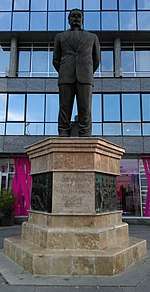 | ||
| Todor Aleksandrov | 350,000 | Češma Park, Municipality of Kisela Voda | ||
| Metodija Andonov-Čento | 800,000 | Macedonia Square, in front of Trend building | ||
| ASNOM | 1.9 million | Žena Borec Park, across 11 October Street from Parliament Building | ||
| Josif Bageri | in front of National Theatre | |||
| Gemidzii | 970,000 | Macedonia Square, on Vardar Quay | 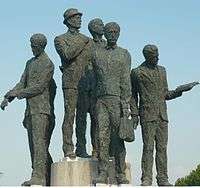 | |
| Pjetër Bogdani | Macedonia Square, near end of Stone Bridge | |||
| Vasil Čakalarov | 330,000 | at intersection of Metropolitan Theodosius Gologanov Boulevard and Kosturski Heroi Street | ||
| Dimitrija Čupovski | 80,000 – 141,000 | Macedonia Square | 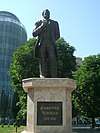 | |
| Defenders of Macedonia (Fallen soldiers of the Insurgency in the Republic of Macedonia) |
232,800 – 320,000 | Žena Borec Park | ||
| Goce Delčev | 850,000 | Macedonia Square, at end of Stone Bridge | ||
| Dame Gruev | 850,000 | Macedonia Square, at end of Stone Bridge | ||
| Pitu Guli | 118,192 | opposite the Parliament Building, Žena Borec Park | ||
| Fallen Heroes of Macedonia | 2.3 million | Žena Borec Park | .jpg) | |
| Founders of the Internal Macedonian Revolutionary Organization | 1.2 million | Žena Borec Park | ||
| Fountain of the Mothers of Macedonia | Karpoš's Rebellion Square |  | ||
| Horses Fountain | Karpoš's Rebellion Square | |||
| Kuzman Josifovski-Pitu | near Defenders of Macedonia monument | |||
| Nikola Karev | 715,000 | in front of Parliament Building | ||
| Karpoš | 540,000 | eastern bank of Vardar, in front of Museum of Archaeology | ||
| Krste Misirkov | 170,000 – 180,000 | Krste Misirkov Park, near Appellate Court | ||
| Gjorče Petrov | 350,000 | Municipality of Gjorče Petrov |  | |
| Warrior Monument | 330,000 | Avtokomanda | .jpg) | |
| Dimitar Popgeorgiev | 67,000 | Macedonia Square, in front of Narodna Banka Building | ||
| Gjorgji Pulevski | 142,000 | eastern bank of Vardar, in front of Museum of the Macedonian Struggle, just north of Stone Bridge | ||
| Saints Clement and Naum of Ohrid | 580,000 | eastern bank of Vardar, at end of Stone Bridge | ||
| Saints Cyril and Methodius | 540,000 | eastern bank of Vardar, at end of Stone Bridge | ||
| Jane Sandanski | 250,000 | Municipality of Aerodrom | 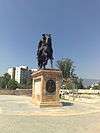 | |
| Boris Sarafov | near the Ministry of Foreign Affairs | |||
| Pavel Šatev | near the City Trade Center and Porta Macedonia | |||
| Hristo Tatarčev | near intersection of Dimitrija Čupovski and 11 October Streets, near Porta Macedonia | |||
| Hristo Uzunov | 120,000 | opposite Ministry of Justice, on Dimitrija Čupovski Street | ||
Miscellaneous
Docked boats in Vardar River
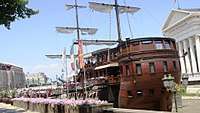
The first of four building-boats as restaurants and cafes just in the Vardar River opened in July 2014. The boats are erected into the riverbed and, thus, will remain in their planned spots permanently. The boats, all to be situated in central Skopje, were intended to be in the Baroque style.[100][101]
Ferris wheel
The erection of a Ferris wheel is foreseen on the Vardar River. It will require the construction of a new pedestrian bridge, to run from the Museum of the Macedonian Struggle to the MEPSO Building, upon which it will stand. No final plan for the project has been approved.[102]
In 2020, following the cancellation of construction on the Ferris wheel, the completed bridge was opened to pedestrians.[103]
Fountains in Vardar River
The addition of fountains on the Vardar River was planned early on in the project. They were completed in 2010. The fountains have been criticized for reportedly releasing mud, as well as for acting as a filter for trash flowing down the river.[104]
Kale Fortress reconstruction
Director of Cultural Heritage and archaeologist Pasko Kuzman has announced a plan to restore and reconstruct the Kale Fortress. The plan also includes the construction of a museum to house Byzantine archaeological finds from the fortress, as well as reconstructions of a prehistoric house and an Ottoman guard tower to be built on the place of their ruins. Souvenir shops and cafes are also foreseen additions. The most controversial part of the restoration of the fortress is the construction of a church, which has been protested by ethnic Albanians.[105]
Karpoš's Rebellion Square reconstruction
Karpoš's Rebellion Square is situated opposite the Vardar River of Macedonia Square and is undergoing a significant reconstruction. Plans include the erection of a statue and fountain depicting Phillip II of Macedon, though officially named "Warrior," at the far northeast side of the square. Another monument consisting of a fountain and statues representing the Mothers of Macedonia is being constructed in front of the Warrior monument. In front of this will be two monuments, also consisting of a fountain and statues, depicting horses. The two will be situated on either side of the entrance to the square from the Stone Bridge.[106]
Office building on Macedonia Square

A new office building was constructed on the south side of Macedonia Square, on the Vardar Quay. It stands on the same place as the former headquarters of the National Bank, which was destroyed in the 1963 Skopje earthquake. The new office building is similar in shape to the former bank building, though it is not in the neoclassical style, which also makes it somewhat unusual in the Skopje 2014 project.[107]
Skanderbeg Square
_ve_Skopji%2C_bila_budova_v.jpg)
An existing statue of Skanderbeg, an important historical figure to ethnic Albanians, is the main fixture of a square that bears his name in Skopje's Čair Municipality. The square's total cost is estimated at around 10 million euros and was completed in 2018. The square covers 28,000 m2 (301,389 ft2) and extends from the Macedonian Philharmonic and Macedonian Opera to the Old Bazaar. To accommodate construction a portion of the square was built on top of Goce Delčev Boulevard. Aside from plenty open space, the square contains an amphitheatre, a fountain, and underground parking.[108][109]
Other
.jpg)
Other components of Skopje 2014 include the following:
- 202 double-decker city buses, like London, in city's routes.
- Three willow trees planted in the Vardar River in central Skopje.[110]
- The restoration of buildings in the historic Old Bazaar.[111][112]
- Hotels, including a Marriott Hotel constructed in May 2016 on Macedonia Square.[113]
- Parking garages.[114]
See also
References
| Wikimedia Commons has media related to Skopje 2014. |
- EastWest Institute (2000). Jonathan P. Stein, ed. The Politics of National Minority Participation in Post-Communist Europe: State-Building, Democracy, and Ethnic Mobilization. M.E. Sharpe. p. 91. ISBN 978-0-7656-0528-3.
- Marusic, Sinisa. "Skopje 2014 Forges Ahead Despite Macedonian Crisis". Skopje: Balkan Story. Retrieved 30 July 2012.
- Janev, G. (2015). ‘Skopje 2014’: erasing memories, building history. In M. Couroucli, & T. Marinov (Eds.), Balkan heritages: Negotiating history and culture (pp. 111-130). Taylor & Francis, 2017, ISBN 1134800754.
- Bugjevac, Dejan (2007). "СКОПЈЕ ЌЕ УМРЕ ОД НЕВКУС". Globus (in Macedonian). Retrieved 8 June 2012.
- Koteska, Jasna (29 December 2011). "Troubles with History: Skopje 2014". Art Margins Online. Republic of Macedonia. Retrieved 8 June 2012.
- The New York Times International Edition, October 14, 2016, pg. 19
- Marking the 44th anniversary of the catastrophic 1963 Skopje earthquake Archived 2007-09-30 at the Wayback Machine MRT, Thursday, 26 July 2007
- Marusic, Siniša (11 May 2012). "Skopje 2014: The new face of Macedonia, updated". Skopje: BalkanInsight. Retrieved 27 July 2012.
- "PM Gruevski: Yes, Skopje 2014 was my Idea". MINA. 7 January 2012. Retrieved 30 July 2012.
- Is Macedonia's capital being turned into a theme park?, CNN, October 10, 2011
- Macedonian Culture Strategy: Milestone or Wish List?, BalkanInsight, 15 Nov 12
- "SDSM Allegations at Government on Skopje 2014 Project". Skopje: SkopjeDiem. 30 March 2011. Archived from the original on 4 January 2013. Retrieved 30 July 2012.
- Ghosts of the past endanger Macedonia's future. Boris Georgievski, BalkanInsight, October 27, 2009 .
- The Guardian, Macedonia statue: Alexander the Great or a warrior on a horse?, Sunday 14 August 2011
- The Changing Face of Skopje, Euronews.com, May 5, 2011
- Stefoska, Irena; Stojanov, Darko (2017). "A tale in stone and bronze: old/new strategies for political mobilization in the Republic of Macedonia" (PDF). Nationalities Papers. 45 (3): 364. doi:10.1080/00905992.2017.1308346.CS1 maint: ref=harv (link)
- Maria Couroucli and Tchavdar Marinov eds., Balkan Heritages: Negotiating History and Culture, British School at Athens - Modern Greek and Byzantine Studies, Taylor & Francis, 2017, ISBN 1134800754, p. 218.
- "Macédoine : Skopje 2014, kitsch nationaliste et foire aux antiquités" (in French). Le Courrier des Balkans. 2012. Retrieved 30 July 2012.
- Borian Jovanovski Al Jazeera, 18 March 2015, : "Talking about this project Skopje 2014, yes it's damaging to inter-ethnic relations, it's not reflecting the multi-cultural society that Macedonia is. But on the other hand you have an Albanian party in the government - and they agree - so in a way they have responsibility for what's going on too. It's obvious that it is damaging inter-ethnic relations which are anyway fragile and damaging Macedonian national identity too because it brings us to history that is unknown to us, in which we are a kind of successor to Alexander the Great. This is not true because Alexander the Great is famous because he enlarged the Hellenic culture. We are Slavs who are not Hellenic at all."
- Zoran Zaev, Süddeutsche Zeitung, 27 December 2016, : "Mit dem idiotischen Skopje-2014-Projekt und der zusammenhängenden Pseudo-Geschichtsschreibung, die Alexander den Großen für Mazedonien reklamiert, haben wir nicht nur Griechenland provoziert, sondern auch viel internationale Unterstützung für unsere Position verloren." (English translation: With the idiotic Skopje 2014 project and the related pseudo-historiography that claims Alexander the Great for Macedonia, we have not only provoked Greece, but also lost much international support for our position.)
- "City of Skopje starting to take action on Skopje 2014 project: Mayor". Macedonian Information Agency. Retrieved 9 March 2018.
- "A "Skopje 2014" monument is removed". IBNA. Retrieved 9 March 2018.
- "Macedonia Removes the Skopje 2014 Statue of Andon Kyoseto". EUscoop. Retrieved 9 March 2018.
- "Skopje starts removal of 'irredentist' statues put up by Gruevski government". AMNA. Retrieved 9 March 2018.
- "Removal of monuments in Skopje, whose turn is next?". IBNA. Retrieved 9 March 2018.
- "Skopje authorities start to tear down nationalistic statues". Proto Thema. Retrieved 9 March 2018.
- "Divisive Revolutionary's Statue Vanishes from Macedonian Capital". BIRN. Retrieved 9 March 2018.
- "Macedonia to Rename Divisive Statues that Irked Greece". BIRN. Retrieved 25 September 2018.
- "Мостот на уметноста се искачи на конструкцијата" (in Macedonian). Skopje: Utrinski Vesnik. April 8, 2012. Archived from the original on 13 June 2012. Retrieved 19 June 2012.
- "Мостот Око конечно почна да се гради" (in Macedonian). Skopje: Daily.mk. July 29, 2011. Retrieved 19 June 2012.
- "1.140.000 евра за оградата на мостот кај Холидеј Ин" (in Macedonian). Кирилица. May 9, 2012. Retrieved 2012-06-12.
- ""Барокна" ограда за мостот Гоце Делчев" (in Macedonian). build.mk. 4 November 2011. Retrieved 12 June 2012.
- "Мостот Гоце Делчев во ново светло" (in Macedonian). build.mk. 23 October 2011. Retrieved 12 June 2012.
- "Поставени два лава на мостот Гоце Делчев" (in Macedonian). build.mk. 24 August 2010. Retrieved 12 June 2012.
- Бошковска, Елена (May 16, 2011). "Пуштен во употреба реконструираниот "Мост на Револуцијата"" (in Macedonian). Сител. Retrieved 2012-06-12.
- "ФОТО: Како ќе изгледа новата сала на Македонската Филхармонија?" (in Macedonian). Skopje: Kurir. 14 November 2011. Archived from the original on 20 February 2012. Retrieved 5 July 2012.
- Vasilevski, Žarko. "Во музејот, освен археологија, ќе има и приказна за една величествена историја" (in Macedonian). Nova Makedonija. Retrieved 3 May 2014.
- Ivanovska, Vesna (January 21, 2009). "Археолошки музеј во центарот на Скопје". Dnevnik (in Macedonian). Skopje. Retrieved 22 June 2012.
- "Проберено: Проекти кои што докажано се остартуваат" (PDF). VMRO-DPMNE. Retrieved 3 May 2014.
- "ФОТО ВЕСТ: Свечено отворен Музејскиот комплекс "Македонска борба"" (in Macedonian). Skopje: build.mk. September 9, 2011. Retrieved 19 June 2012.
- "Стариот театар уште "голта" пари" (in Macedonian). Factor. 10 April 2014. Retrieved 3 May 2014.
- Mitevska, Liljana (7 December 2007). "Започна изградбата на новиот МНТ" (in Macedonian). Skopje: Utrinski Vesnik. Retrieved 5 July 2012.
- "Целиот строг центар на Скопје ќе добие нови фасади" (in Macedonian). Skopje: build.mk. 6 March 2012. Retrieved 5 July 2012.
- "Продолжува промената на фасадите околу Плоштадот Македонија" (in Macedonian). Skopje: build.mk. 3 May 2012. Retrieved 5 July 2012.
- "ГТЦ ќе добие нова фасада и надградба" (in Macedonian). Skopje: build.mk. 14 June 2012. Retrieved 5 July 2012.
- "Почнува уредувањето на плоштадот Карпошово востание" (in Macedonian). Skopje: build.mk. Retrieved 28 June 2012.
- "Во мај проект, а летово и тендер за менување на ликот на владината зграда" (in Macedonian). Skopje: build.mk. 22 March 2012. Retrieved 5 July 2012.
- "И главната зграда на МЕПСО со класицистичка фасада" (in Macedonian). Skopje: build.mk. 2 March 2012. Retrieved 5 July 2012.
- Vasilevski, Igor (3 August 2010). "Конкурс - Реконструкција и адаптација на фасада за објект Управна зграда на Министерство за правда во Скопје" (in Macedonian). Architect.mk. Retrieved 5 July 2012.
- Smilevska, Milka (15 June 2009). "Отворени тендерите за реконструкција на Собранието" (in Macedonian). Skopje: Alfa TV. Retrieved 5 July 2012.
- "Камен темелник за новиот објект на АЕК" (in Macedonian). Skopje: build.mk. 30 March 2011. Retrieved 2 July 2012.
- Jovanova, Sonja (30 March 2011). "АГЕНЦИЈАТА ЗА ЕЛЕКТРОНСКИ КОМУНИКАЦИИ ЈА ДОБИВА СВОЈАТА ЗГРАДА" (in Macedonian). Skopje: Kapital. Archived from the original on 21 February 2013. Retrieved 2 July 2012.
- "Поставен камен темелник за новиот Кривичен суд" (in Macedonian). Skopje: build.mk. 29 May 2010. Retrieved 3 July 2012.
- "Камен темелник за зграда на Обвинителството и Финансиската полиција" (in Macedonian). Skopje: build.mk. Retrieved 4 July 2012.
- "Министерството за финансии ќе се сели во "Југобанка"" (in Macedonian). Skopje: build.mk. 8 March 2011. Retrieved 4 July 2012.
- "Официјален камен темелник за новото МНР" (in Macedonian). Skopje: build.mk. Retrieved 4 July 2012.
- "Се гради објект за скопската градска администрација" (in Macedonian). Skopje: build.mk. 3 June 2011. Retrieved 5 July 2012.
- "Грчки инвеститор ќе ги гради Офицерскиот дом и хотелот на Плоштад Македонија" (in Macedonian). Skopje: build.mk. 12 March 2011. Retrieved 5 July 2012.
- "Поставен камен-темелник на новата зграда на ЈП "Водовод и канализација"" (in Macedonian). Skopje: Macedonian Radio-Television. 4 December 2011. Archived from the original on 21 February 2013. Retrieved 5 July 2012.
- Trajkovska, Despina (13 December 2010). "Градската администрација ќе добие зграда под Кале" (in Macedonian). Skopje: Utrinski Vesnik. Archived from the original on 19 February 2013. Retrieved 5 July 2012.
- "Се поставува Јустинијан Први" (in Macedonian). Sky.mk. 17 June 2011. Archived from the original on 3 February 2014. Retrieved 2011-06-18.
- "ЌЕ СЕ ГРАДИ СПОМЕНИК НА МАЈКА ТЕРЕЗА ПОВИСОК ОД ВОИНОТ НА КОЊ" (in Macedonian). Skopje: Fakulteti.mk. 29 June 2012. Retrieved 30 June 2012.
- Dimitrievski, Aleksandar (26 January 2011). "И летниковец ..." (in Macedonian). Skopje: Alfa TV. Retrieved 23 June 2012.
- ""Порта Македонија" свечено претставена на јавноста" (in Macedonian). Skopje: build.mk. January 6, 2012. Retrieved 22 June 2012.
- "Поставен споменикот на Цар Самоил" (in Macedonian). А1. 2011-06-28. Retrieved 2011-07-31.
- "Споменикот на Цар Самоил стигна на плоштадот "Македонија"" (in Macedonian). Dnevnik. 2011-06-28. Archived from the original on 2013-02-19. Retrieved 2011-07-31.
- "The Encyclopedia of World History. 2001. First Bulgarian Empire - Samuil". Archived from the original on April 17, 2008. Retrieved 2008-05-23.
- An outline of Macedonian history from ancient times to 1991. Macedonian Embassy London. Retrieved on 2007-04-28.
- The Oxford Dictionary of Byzantium, Vol 1, New York-Oxford, Oxford University Press, 1991 (p. 1838)
- "Филип Втори поставен на плоштадот "Карпошово востание"" (in Macedonian). Skopje: build.mk. 22 May 2012. Retrieved 29 June 2012.
- Is Macedonia's capital being turned into a theme park? CNN International, 10 October 2011
- Macedonia statue: Alexander the Great or a warrior on a horse? The Guardian, Sunday 14 August 2011
- https://www.citylab.com/design/2013/08/skopjes-strange-quest-rewrite-its-history-through-public-sculpture/6416/
- "Former FM hails Skopje plaque on Alexander the Great statue". Ekathimerini. 16 August 2019. Retrieved 9 June 2020.
- "Пуштање во употреба фонтана со споменикот "Воин на коњ"" (in Macedonian). Skopje: Alfa TV. 8 September 2011. Archived from the original on 23 July 2012. Retrieved 23 June 2012.
- "ПОСТАВЕН СПОМЕНИКОТ НА АЛЕКСАНДАР МАКЕДОНСКИ НАРЕЧЕН "ВОИН НА КОЊ" ВО СКОПЈЕ". www.trtmacedonian.com. Retrieved 20 September 2011.
- "Општина Центар ќе лее нова тура споменици за центарот на Скопје" (in Macedonian). Skopje: build.mk. 3 April 2012. Retrieved 27 June 2012.
- Jakovleski, Martin (26 June 2012). "ТОДОР АЛЕКСАНДРОВ "ДОЈАВА" ВО КИСЕЛА ВОДА" (in Macedonian). Skopje: Telma. Retrieved 27 June 2012.
- Утрински вестик, 18.10.2012, „Војводата на коњ“ и официјално Тодор Александров. Archived 2012-10-22 at the Wayback Machine
- T, Ds (June 7, 2010). "Ченто се исправи пред "Тренд"" (in Macedonian). Skopje: Utrinski Vesnik. Archived from the original on February 19, 2013. Retrieved 25 June 2012.
- "Поставени сите десет АСНОМ-ци спроти Собранието" (in Macedonian). Skopje: build.mk. Retrieved 25 June 2012.
- V, Ž (July 28, 2010). ""Гемиџиите" пристигнаа на кејот" (in Macedonian). Skopje: Nova Makedonija. Archived from the original on September 5, 2012. Retrieved 24 June 2012.
- "Споменици на Васил Чакаларов и Христо Узунов за 450.000 евра" (in Macedonian). Skopje: build.mk. 21 June 2012. Retrieved 27 June 2012.
- "Споменикот на Димирија Чупоски ќе биде до споменикот на Александар Македонски" (in Macedonian). Skopje: Dnevnik. March 3, 2011. Archived from the original on 12 March 2011. Retrieved 26 June 2012.
- "ДУИ се вознемири - погрешен момент за бранителите" (in Macedonian). Skopje: Utrinski Vesnik. 15 February 2011. Archived from the original on 20 February 2011. Retrieved 25 June 2012.
- "Гоце Делчев и Даме Груев дојаваа на "Македонија"" (in Macedonian). Skopje: time.mk. May 3, 2010. Archived from the original on February 21, 2013. Retrieved 25 June 2012.
- "Нови споменици во Центар и во Кисела вода" (in Macedonian). Skopje: build.mk. 26 June 2012. Retrieved 28 June 2012.
- "Се поставуваат скулптурите на Мостот на уметноста, во Жена – парк поставен споменик и на Питу Гули" (in Macedonian). Skopje: build.mk. 9 August 2012. Retrieved 10 August 2012.
- "Поставен споменикот на "Паднати херои за Македонија"" (in Macedonian). Skopje: Stipka. Archived from the original on 10 May 2012. Retrieved 28 June 2012.
- "Филип Втори поставен на плоштадот "Карпошово востание"" (in Macedonian). Skopje: build.mk. 22 May 2012. Retrieved 28 June 2012.
- "Ќе се издигне седумметарскиот споменик на Никола Карев" (in Macedonian). Skopje: Večer. 13 September 2011. Archived from the original on 13 September 2012. Retrieved 27 June 2012.
- "БЛИЦ ВЕСТ: Поставен споменикот на Карпош" (in Macedonian). Skopje: build.mk. Retrieved 27 June 2012.
- "Откриен споменикот на Крсте Петков Мисирков" (in Macedonian). Skopje: Nova Makedonija. May 13, 2011. Archived from the original on February 19, 2013. Retrieved 26 June 2012.
- Smilevska, Milka (2 June 2011). "350.000 евра за споменик на Ѓорче Петров во Скопје" (in Macedonian). Skopje: Alfa TV. Archived from the original on 12 September 2012. Retrieved 29 June 2012.
- Krstevski, Antonio (21 June 2011). "Поставен споменик на Филип Втори Македонски во Автокоманда" (in Macedonian). Skopje: Sitel. Retrieved 29 June 2012.
- Dimitrievski, Aleksandar (7 May 2011). "Скопје се разбуди со четири нови споменици" (in Macedonian). Skopje: Alfa TV. Retrieved 26 June 2012.
- Spasovski, Aleksandar (12 June 2010). "Поставени спомениците на Свети Климент и Наум и на Свети Кирил и Методиј" (in Macedonian). Skopje: Sitel. Retrieved 27 June 2012.
- "Споменикот на Сандански поставен среде новиот парк во Аеродром" (in Macedonian). Skopje: Dnevnik. 26 May 2011. Archived from the original on 19 February 2013. Retrieved 29 June 2012.
- "ФОТО: Споменик на Сарафов поставен кај МНР". Kurir. 8 April 2013. Retrieved 3 May 2014.
- ""Заплови" првата галија во Вардар" (in Macedonian). 21 July 2014. Retrieved 24 July 2014.
- "Избрани идејните решенија за сплавови на Вардар" (in Macedonian). Skopje: Sitel. 3 March 2012. Retrieved 20 July 2012.
- "Панорамското тркало ќе се гради на нов мост" (in Macedonian). Skopje: Plusinfo. 21 December 2011. Retrieved 8 July 2012.
- (in Macedonian). Skopje: sdk. 19 January 2020 https://sdk.mk/index.php/dopisna-mrezha/mostot-bez-panoramskoto-trkalo-ke-bide-zavrshen-vo-mart-skopskiot-kej-proletva-prooden-posle-6-godini/. Retrieved 15 April 2020. Missing or empty
|title=(help) - "Потскокна и фонтаната во Вардар" (in Macedonian). Skopje: Kirilica. 7 September 2011. Retrieved 17 July 2012.
- Trpčevska, Daniela (24 August 2011). "Отомански кули и праисториски куќи ќе никнат на Кале" (in Macedonian). Skopje: build.mk. Retrieved 8 July 2012.
- "Почнува уредувањето на плоштадот Карпошово востание" (in Macedonian). Skopje: build.mk. 6 July 2011. Retrieved 27 July 2012.
- Naumovska, Sanja (8 August 2008). "Новата зграда во Скопје само ќе личи на Народната банка" (in Macedonian). Skopje: Utrinski Vesnik. Retrieved 12 July 2012.
- ""Скендер Бег" готов до 2014 - та" (in Macedonian). Skopje: build.mk. 28 November 2011. Archived from the original on 26 July 2012. Retrieved 27 July 2012.
- "Плоштадот Скендерг-бег ќе чини 10 милиони евра" (in Macedonian). Skopje: Time.mk. 21 October 2011. Archived from the original on 19 February 2013. Retrieved 27 July 2012.
- "Трите врби ќе растат во Вардар по "наредба" на Србија!?" (in Macedonian). Skopje: Plusinfo. 1 July 2008. Retrieved 20 July 2012.
- "Ќе се обновуваат 250 фасади на објекти со културно – историско значење" (in Macedonian). Skopje: build.mk. 25 April 2012. Retrieved 27 July 2012.
- Ognjanov, Toše (17 February 2010). "Почнува ревитализацијата на скопската чаршија" (in Macedonian). Skopje: Dnevnik. Archived from the original on 4 March 2010. Retrieved 27 July 2012.
- "Скопје ќе добие Marriott Hotel" (in Macedonian). Skopje: build.mk. 14 May 2010. Retrieved 27 July 2012.
- ""Никофон" ќе гради катна гаража во "барокен" стил спроти Старата железничка станица, "Макоил" близу плоштадот Македонија" (in Macedonian). Skopje: build.mk. 7 June 2012. Retrieved 27 July 2012.

